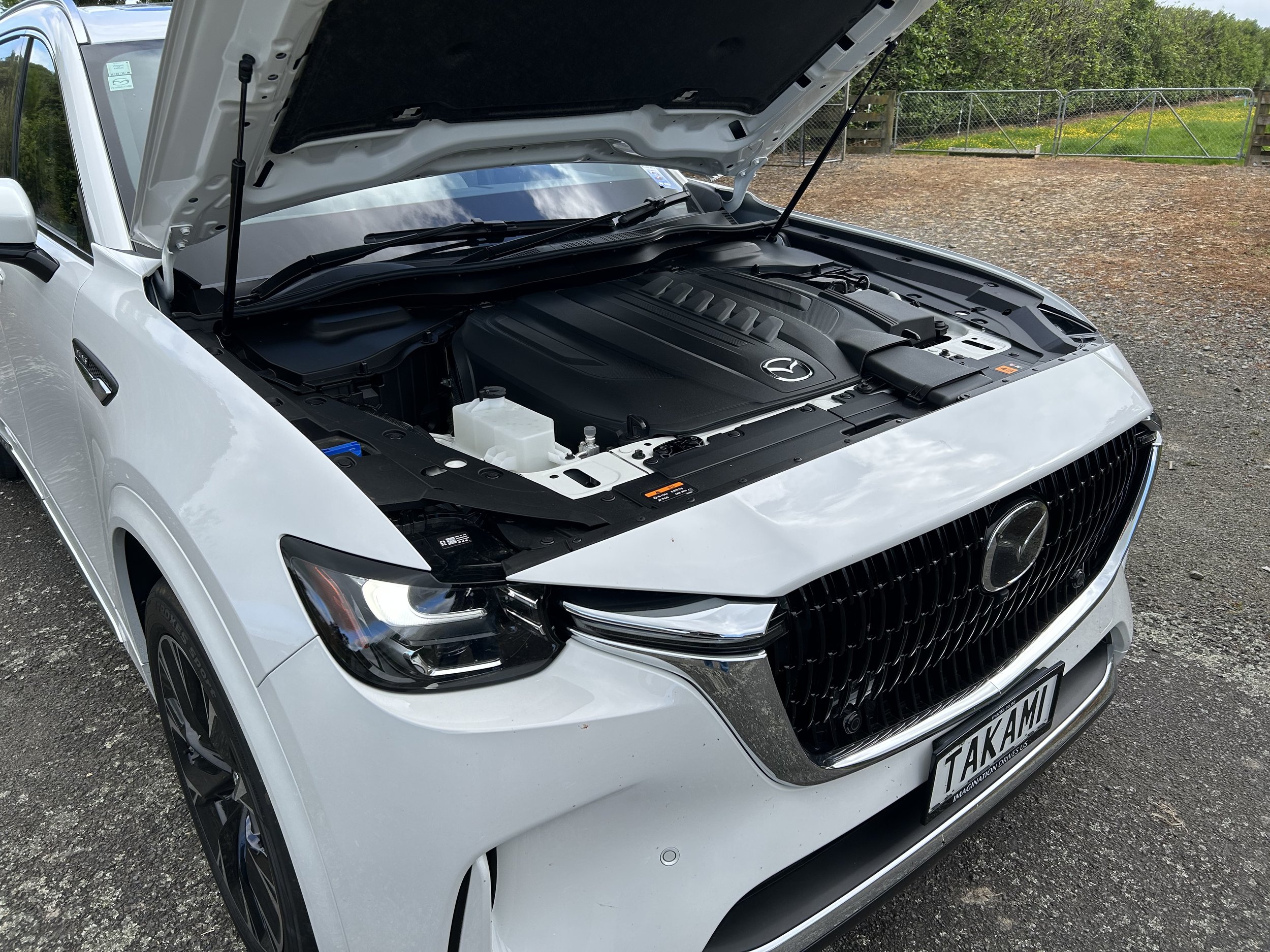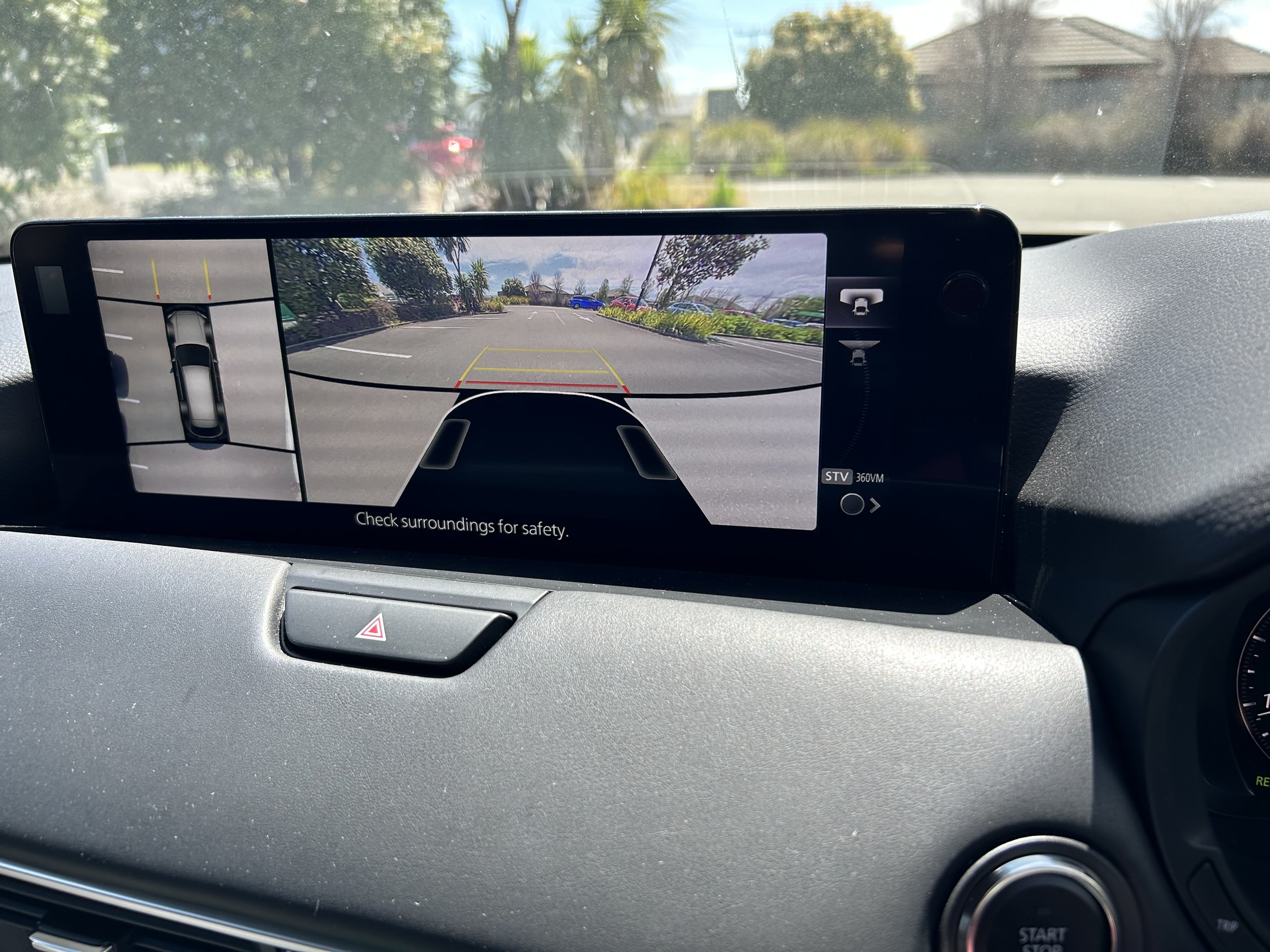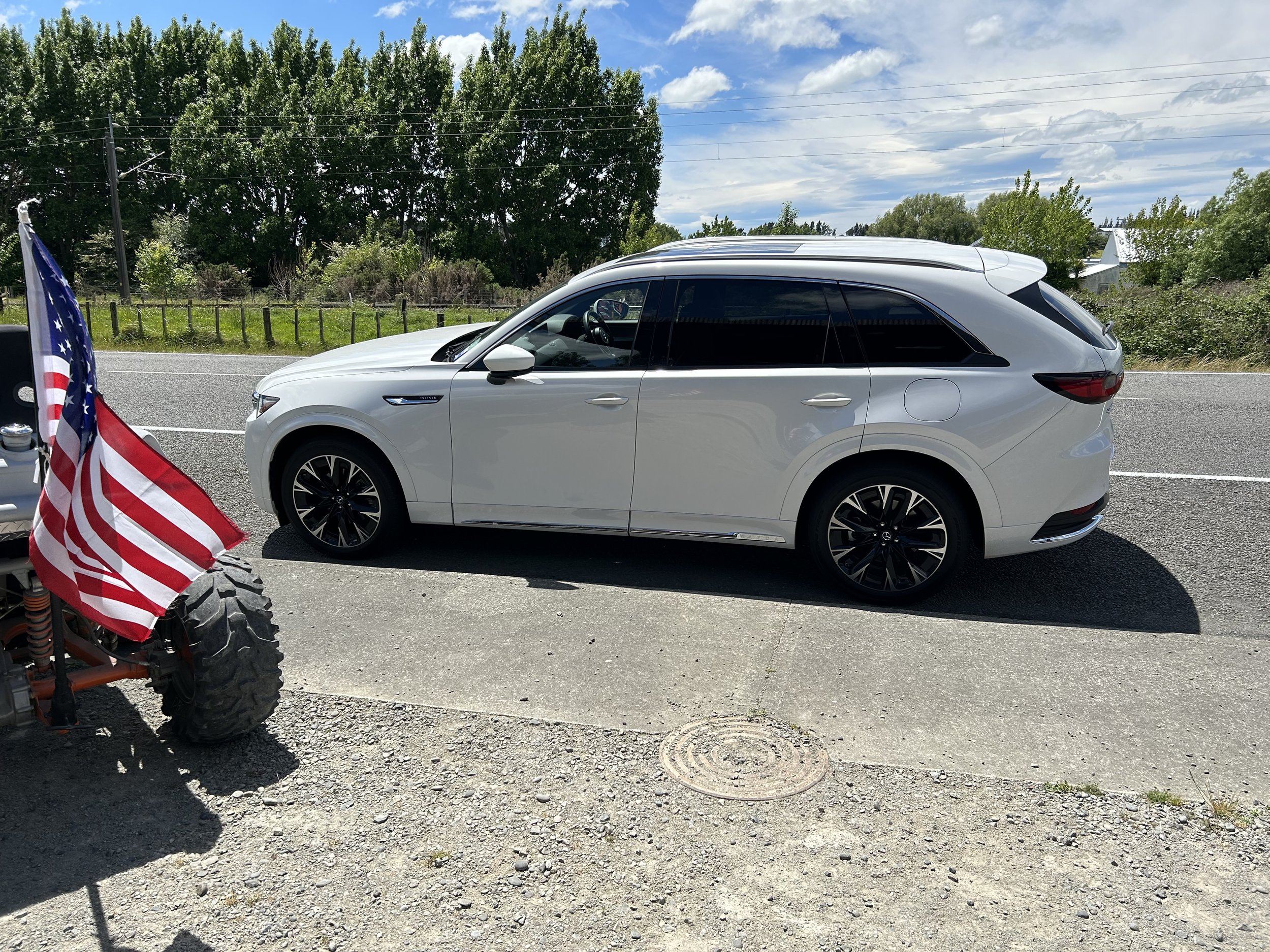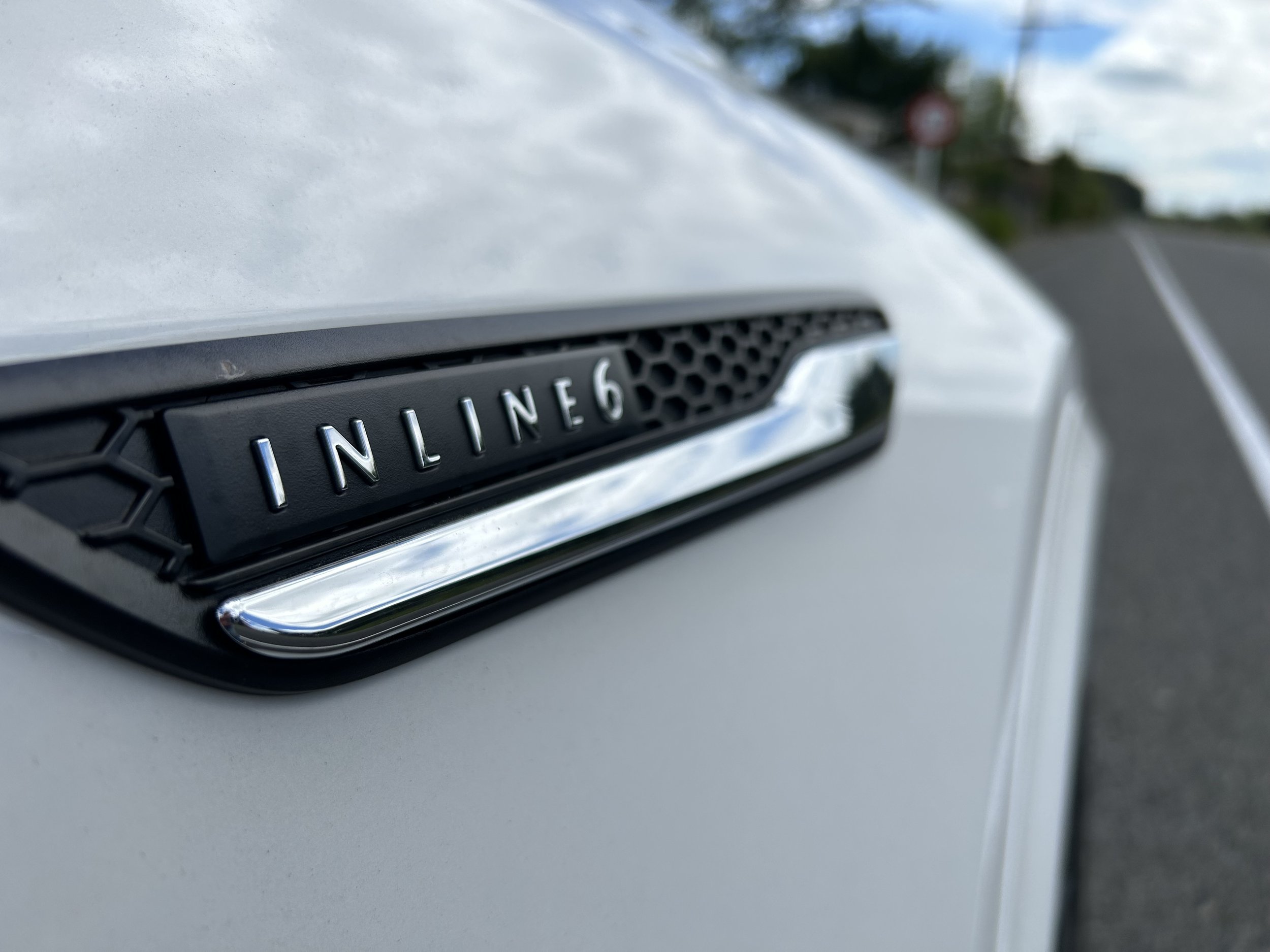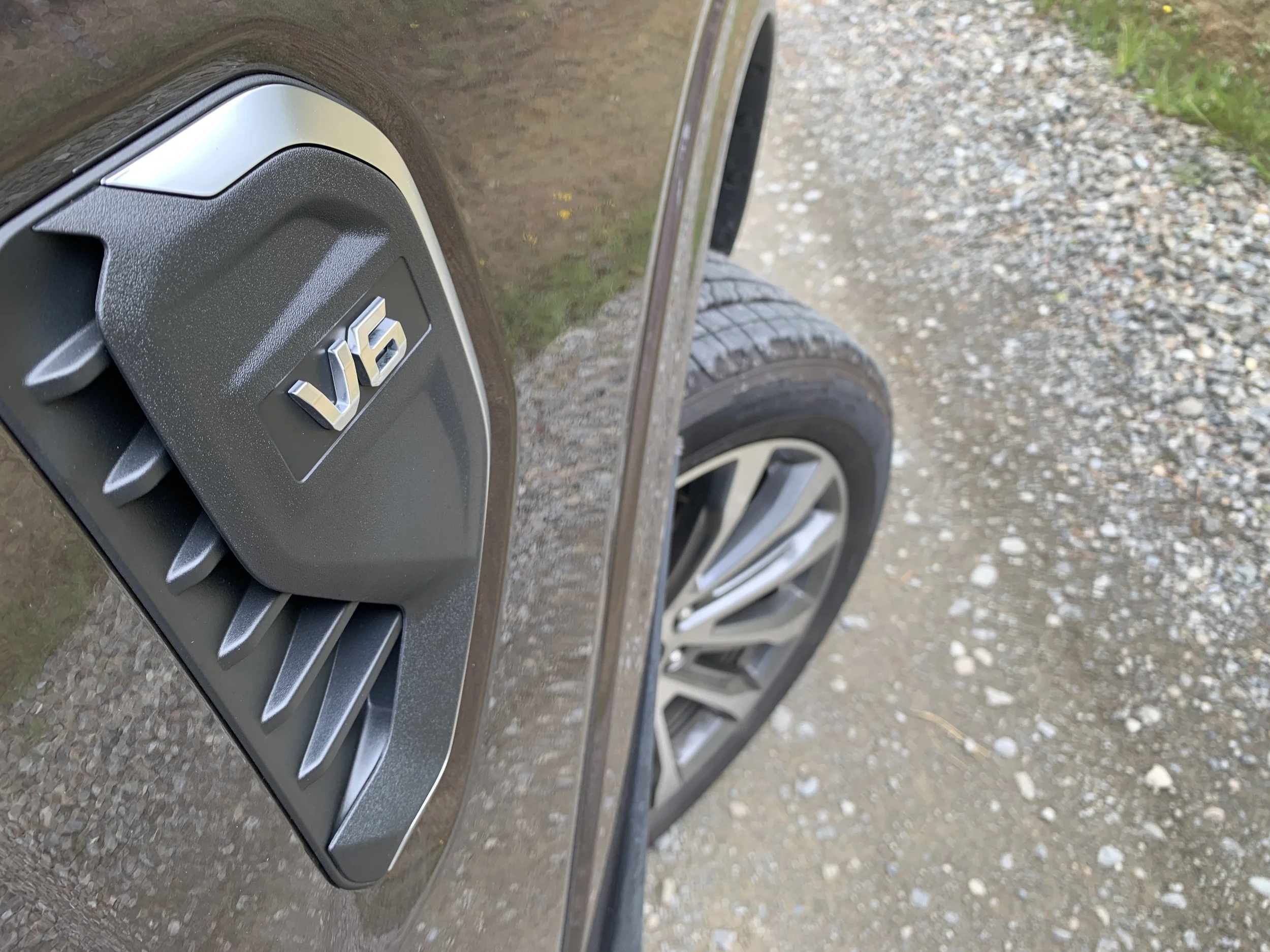Mazda CX-90 Takami road test review: Think big project
/The big guy dresses more tidily, has better manners and the six-cylinder suits it, too.
Price: $92,990.
Powertrain and efficiency: 3.3 litre inline six with 48 volt assist, 254kW/500Nm, eight speed transmission.
Vital statistics: 5100mm long, 1708mm wide, 1748mm high, mm wheelbase; luggage capacity 275-2025 litres; 275/45 21 inch wheels.
We like:. Spacious third row, driver-tuned chassis, build quality.
Not so much: Transmission thump; six is smooth but would the market take more to a PHEV now?
THREE’S a crowd? Whoever said that didn’t work in the car industry.
Three is easy unless you’re talking about a hard-out sports car. Even then, it’s not impossible. Thinking of you, McLaren F1.
Anything with a seat in the back will accommodate four, maybe in discomfort (yes, this time the finger points to petrol Mustang) but it’s possible.
If you’re looking for a tough number, think seven.
Family units are supposedly getting smaller, but there are a lot out there who either didn’t read the handbook, or simply ignored it.
Seven asks for three rows of seats. In Mazda-speak, seven for the past few years has asked for nine. No longer. Now the required score is 90.
Ostensibly, the CX-90 is much the same kind of car, designed fulfil the same kind of functions, as the CX-9 it effectively replaces. And yet, there are big differences.
Most obviously, CX-9 had four. CX-90 rolls a six. Cylinders, that is. History might well record Mazda as among the very last car makers to introduce a new internal combustion engine at the very time when most carmakers are retiring theirs, in favour of electric solutions. If that’s the case, they’re going out of the fossil fuelled-era big.
Competitors will call the 3.3-litre a risk they wouldn’t take; much more so than the other engine the small Hiroshima firm has also delivered this year, a 2.5-litre plug-in hybrid.
In some other places, most notably North America, the latter also goes into the CX-90. An interesting decision, given how the Yanks are supposedly still craving for big capacity oomph. It’s settling in nicely there, by the way.
In NZ, the opposite approach. The 3.3 is the sole choice for the CX-90 and otherwise sites as an option, limited to the single Homura grade, in CX-60; the five chair car otherwise wholly dedicated to PHEV play.
MotoringNZ tested the CX-60 with a six in October. Fair to say it intrigued … but also ultimately didn’t appeal, coming across as an overcompensation. Does it seem more at home in the platform-sharing larger, heavier and very much more commodious CX-90? No point for prevarication. Yes, it does.
The new engine is just one change. The ethos of CX-90 might be broadly the same as CX-9’s - basically, family hauler with plenty of plush - but they are the same car, different car.
That zero means more zeroes. CX-9 Takami in its day was sensitively positioned, price-wise. Mazda NZ announcing pre-launch day that the CX-90 would be $19,000 more was… hmmm. A big call.
To be fair, you get more for paying more. First day of test with the new big fella allowed opportunity to size it up against the old.
It’s as though someone’s been into Uncle Arnie’s steroid stash. CX-9’s big. The most space efficient shape is a box, and that’s basically what the CX-90 is. But it’s a bigger box, now. Taller, wider and, more obviously, longer. Measuring 5.1m long and nearly 2m wide, the new platform delivers 280mm of extra wheelbase and that’s resulted in a commodious cabin.
It has an emphatically more spacious second row than the CX-9, but the bigger difference comes when sizing up the rear-most rows.
I’m not saying these won’t still be reserved as they always tend to be, for children. Yet I would suggest the full-grown of us could put up with being back there, if for a short time.
It’s only the limited foot space that will cause whingeing. Should room is okay, head room fine. And the seats themselves are comfy. With the third row folded into the boot floor, there’s a vast 608-litre luggage area; if the second row is also stowed that volume uplifts to 2025L. Even with the full seven-seat capacity instated, 275L of space remains at the back. That alone is a 59 litre improvement over CX-9. In that respect, it’s strongly fit for purpose.
We’re skirting the real challenge to buy-in, which is that Mazda’s pitch goes further than intriguing drivetrains and bigger body stylings.
With CX-90 as much as CX-60, Mazda is hooked on P. For ‘premium.’ The pitch explaining both carrying significant price tags is that they are now well-developed and presented enough to rate as credible alternatives to the traditional mainstream premium products.
At launch time, we pondered what sort of toff brand allegiances are swayed by this proposition. From retail level feedback, they’re not seeing BMW, Mercedes and Audi trades. From what I hear, CX-90 buyers, if swapping keys, are bringing in CX-9s.
What qualifies ‘premium-ness’ anyway? It’s a sticky question CX-90 answers with a look of quality and solidity that resonates not just outside, but inside too. The cabin is, generally speaking, finely built and well-considered, with great views out and the sort of ease of operation that's something of a Mazda signature.
It also goes to town on wheel size, with 21-inch rims, leather upholstery with heaters for front and second-row occupants and electric adjustment for the front row, a panoramic sunroof, Bose sound system, LED headlights, digital central and instrument screens, and a head-up display.
Ultimately, perhaps it’ll rely on occupants sensing they’re in a plusher environment; if you’ve had the CX-9, will you be able to feel the $13k difference?
Passenger opinion is often valid, but some of what I heard was coloured. This test coincided with a motorsport event for which the CX-90 was conscripted for ferrying friends who were racing. They also happened to be involved in the car industry.
That meant they know what to look for; as they also worked for a competitor brand, though, also meant they were keen to pick it apart. They were merciless with comment that would have stung Mazda ears. Well, what would they expect from the ‘opposition’?
Other views were also gained, of more moderate nature. There was positive feedback on the thoughtfulness of passenger-aimed comfort features including the easy-entry to the second and third rows, USB-C sockets, plenty of cupholders and air vents. There are a number of places in which stuff can be stowed away, the bin between the front seats seemed perfect-sized for an iPad. A touch too perfect, perhaps. It sat so snuggly that getting it out took a lot of dextrity.
However, so much reminded that perception of quality is very much far from hard and fast. Takami definitely delivers fine materials, not least some extremely good seat finishes. Yet it be fair to argue, nonetheless, that had a prestige European make involved, you wouldn’t have to put up with unpleasantly hard lower dash plastics. Clearly some decisions in respect to function have prioritised.
On the other hand, you’ll look fruitlessly for outright ‘cheapness’. Excellent fit and finish has long tended to be a prevailing element of Hiroshima’s product. Effort to maintain that has stepped up here.
Though my mates’ quibble about the over-firmness of the second-row pews does seem reasonable, I remained more positive about the potential of this car displaying a real sense of wellbeing, not least on long journeys. The trim being plush to point where it seemed just too good to expose to uncaring kids’ pummelling could become a ‘thing’. On the other hand, I’d also stick with my thought that it is as exquisitely-trimmed as the much pricier Hyundai Palisade.
The largest and most expensive mainstream car yet sold by the make here going so big on the engine front will demand consideration.
This 254kW/500Nm 3.3-litre aided by a 48-volt mild-hybrid system and driving the rear wheels is a big change from the CX-9’s 170kW/420Nm turbocharged four-cylinder, feeding front-drive or more than just performance alone.
In provisioning their petrol six with electric assist of this level, Mazda is replicating a play made by Mercedes-Benz, with same outcome. Notably, there’s the ability - best demonstrated at 100kmh on flat roads and an even throttle - to coast with the engine-off and sustain forward momentum on the electric motor/generator.
That’s a positive influence on fuel burn from a power plant that is, unsurprisingly, suave, characterful in note and relaxingly muscular. As found in CX-60, though, the engine only demonstrates ability to lean out fairly well in open road behaviour. Urban consumption is less agreeable.
The overall return of 10.8 litres per 100km might seem high for some, not least if seven-seater hybrids are on the consideration shortlist. On the other hand, that was better than the CX-60, which swung from 7.7L/100km on the open road to 11.5 on the city beat. Considering the CX-90 offers more seating and is clearly larger and heavier, at 2.2 tonnes before any humans slide in, that’s gotta be considered a win of sorts.
Vehicles of this genre aren’t intended to be sports cars - though quite a few are sports utilities - but Mazda’s credo for delivering driver excitement prohibits the CX-90 from loafing along.
It drives with enough body control to keep things surprisingly tight if you're in a hurry on a windy road. The ride quality is interesting; it’s firm for the type with one aboard and, while bump suppression isn’t too bad, expectation that it might settle down into something more magic carpet-like with a full load doesn’t wholly realise.
The driving position being quite car-like might also appeal to those who find that so many MPVs take the whole family bus thing to too much extreme, with tall and upright placements. By comparison, CX-90 is more like a big car, but doesn’t suffer from that. Visibility is good, for instance.
A couple of things sit in the ‘could do better’ file. One is that, while the in-house-developed eight-speed automatic is sensibly geared, it’s quirkily better when the car is being driven with aptitude then when it cruises. In latter mode, the shifts are occasionally racked by sudden abrupt thumps. A result of Mazda having gone to single clutch system? Who knows, but it’s not what you want from a car that otherwise does well in respect to refinement. The CX-60 Homura was also blighted, but it seemed more frequent and obvious in the CX-90.
Also, there’s the infotainment. As with the CX-60, the central screen does not become touch-sensitive for the native menu system or Apple CarPlay/Android Auto until the vehicle is at a standstill and in Park. Mazda says this was pressed upon it by need to meet some obscure ANCAP rule but, frankly, it’s a pain.
The only way to navigate screen operations when the car is driving is by using the console-mounted rotary controller, which even with nudge capacity is clumsy.
The CX-90 has yet to rated by our national safety accreditor, ANCAP, but on strength of Mazda’s past performances and also from the sheer span of safety equipment, it seems well-sorted. The CX-90 has 10 airbags, including curtain bags that cover the third row, frontal collision warning, AEB with pedestrian/cyclist detection and reversing mode, blind spot monitoring, driver fatigue monitoring, lane-keep assist, frontal and rear cross traffic alert, front and rear parking sensors and a 360-degree camera view. That’s a lot of the right boxes ticked.
All in all, the CX-90 stands out for more than just being rather large. Whether a vehicle of this ilk is the best format to imprint a premium push is a tricky one.
It’s aimed, after all, primarily at family users. Is an exercise in plush a risk for the Daycare run when potentially little Timmy and his mates’ prime objective as passengers is to punish the interior?
As much as that 3.3-litre seems a more comfortable fit in this model than it came across as being in the CX-60, there’s still sense it’s potential would be more fully fulfilled were it to take the hybrid drivetrain. Which might be on the cards.
The powertrain that delivers advantage of some pure electric drive, a much lower CO2 output, much greater thrift and 241kW and 500Nm is about to enter right-hand drive production. Our neighbour has reportedly signed up, with media across the Tasman expecting to see it in their showrooms next year.
Where Australia goes, will NZ follow?


